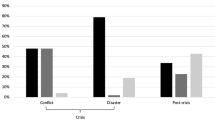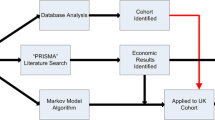Abstract
Purpose
Data on the epidemiological characteristics of traumatic amputations in prehospital emergency care, especially in the context of air rescue, are scarce. Therefore, we aimed to describe the epidemiology of total and subtotal amputation injuries encountered by the OEAMTC helicopter emergency medical service (HEMS) in Austria, based on an almost nationwide sample.
Methods
We retrospectively reviewed all HEMS rescue missions flown for amputation injuries in 2009. Only primary missions were analyzed.
Results
In total, 149 out of 16,100 (0.9 %) primary HEMS rescue missions were for patients suffering from amputation injuries. Among these, HEMS physicians diagnosed 63.3 % (n = 94) total and 36.9 % (n = 55) subtotal amputations, with both groups showing a predominance of male victims (male:female ratios were 8:1 and 6:1, respectively).The highest rate occurred among adults between 45 and 64 years of age (35.6 %, n = 53). The most common causes were working with a circular saw (28.9 %, n = 43) and processing wood (16.8 %, n = 25). The majority of the cases included digital amputation injuries (77.2 %, n = 115) that were mainly related to the index finger (36.2 %, n = 54). One hundred forty patients (94.0 %) showed a total GCS of more than 12. Amputations were most prevalent in rural areas (84.6 %, n = 126) and between Thursday and Saturday (55.0 %, n = 82). The replantation rate after primary air transport was low (28 %).
Conclusions
In the HEMS, amputation injuries are infrequent and mostly not life-threatening. However, HEMS crews need to maintain their focus on providing sufficient and fast primary care while facilitating rapid transport to a specialized hospital. The knowledge of the epidemiological characteristics of amputation injuries encountered in the HEMS gained in this study may be useful for educational and operational purposes.



Similar content being viewed by others

References
European Commission. Causes and circumstances of accidents at work in the EU. Luxembourg: Office for Official Publications of the European Communities, 2009. http://www.ec.europa.eu/social/BlobServlet?docId=2785&langId=en. Accessed 20 April 2011.
Conn JM, Annest JL, Ryan GW, Budnitz DS. Non-work-related finger amputations in the United States, 2001–2002. Ann Emerg Med. 2005;45(6):630–5. doi:10.1016/j.annemergmed.2004.10.012.
Hostetler SG, Schwartz L, Shields BJ, Xiang H, Smith GA. Characteristics of pediatric traumatic amputations treated in hospital emergency departments: United States, 1990–2002. Pediatrics. 2005;116(5):e667–74. doi:10.1542/peds.2004-2143.
Conner KA, McKenzie LB, Xiang H, Smith GA. Pediatric traumatic amputations and hospital resource utilization in the United States, 2003. J Trauma. 2010;68(1):131–7. doi:10.1097/TA.0b013e3181.
Injury Database Austria. 2008. http://www.bmsk.gv.at/cms/site/attachments/4/9/1/CH0147/CMS1224077606935/idb_austria_jahresbericht_2008_pdf. Accessed 19 April 2012.
Bledsoe BE, Wesley AK, Eckstein M, Dunn TM, O’Keefe MF. Helicopter scene transport of trauma patients with nonlife-threatening injuries: a meta-analysis. J Trauma. 2006;60(6):1257–65. doi:10.1097/01.ta.0000196489.19928.c0. (discussion 65-6).
Kuhne C, Zettl R, Ruchholtz S. Selection of the designated medical center after trauma. Nofall Rettungsmed. 2008;11:381–5.
Ozer K, Kramer W, Gillani S, Williams A, Smith W. Replantation versus revision of amputated fingers in patients air-transported to a level 1 trauma center. J Hand Surg Am. 2010;35(6):936–40. doi:10.1016/j.jhsa.2010.02.031.
Statistics Austria. Austria within the European Union. 2007. http://www.statistik.at/web_de/services/wirtschaftsatlas_oesterreich/oesterreich_innerhalb_der_eu/index.html. Accessed 19 April 2012.
Kruger AJ, Lockey D, Kurola J, Di Bartolomeo S, Castren M, Mikkelsen S, Lossius HM. A consensus-based template for documenting and reporting in physician-staffed pre-hospital services. Scand J Trauma Resusc Emerg Med. 2011;19:71. doi:10.1186/1757-7241-19-71.
Dillingham TR, Pezzin LE, MacKenzie EJ. Incidence, acute care length of stay, and discharge to rehabilitation of traumatic amputee patients: an epidemiologic study. Arch Phys Med Rehabil. 1998;79(3):279–87. pii:S0003-9993(98)90007-7.
Boyle D, Parker D, Larson C, Pessoa-Brandao L. Nature, incidence, and cause of work-related amputations in Minnesota. Am J Ind Med. 2000;37(5):542–50. doi:10.1002/(SICI)1097-0274(200005)37:5<542:AID-AJIM10>3.0.CO.
Kobayashi L, Inaba K, Barmparas G, Criscuoli M, Lustenberger T, Talving P, Lam L, Demetriades D. Traumatic limb amputations at a level I trauma center. Eur J Trauma Emerg Surg. 2011;37:67–72.
Gavrilova N, Harijan A, Schiro S, Hultman CS, Lee C. Patterns of finger amputation and replantation in the setting of a rapidly growing immigrant population. Ann Plast Surg. 2010;64(5):534–6. doi:10.1097/SAP.0b013e3181bffcaf.
Richards WT, Barber MK, Richards WA, Mozingo DW. Hand injuries in the state of Florida, are centers of excellence needed? J Trauma. 2010;68(6):1480–90. doi:10.1097/TA.0b013e3181bb8c70.
Atroshi I, Rosberg HE. Epidemiology of amputations and severe injuries of the hand. Hand Clin. 2001;17(3):343–50. (vii).
Lindfors N, Raatikainen T. Incidence, epidemiology, and operative outcome of replantation or revascularisation of injury to the upper extremity. Scand J Plast Reconstr Surg Hand Surg. 2010;44(1):44–9. doi:10.3109/02844310903259074.
Nylander G, Vilkki S, Ostrup L. The need for replantation surgery after traumatic amputations of the upper extremity–an estimate based upon the epidemiology of Sweden. J Hand Surg Br. 1984;9(3):257–60.
Liang HW, Chen SY, Hsu JH, Chang CW. Work-related upper limb amputations in Taiwan, 1999–2001. Am J Ind Med. 2004;46(6):649–55. doi:10.1002/ajim.20098.
Vilkki SK, Goransson H. Traumatic amputations and the need for a replantation service in Finland. Ann Chir Gynaecol. 1982;71(1):2–7.
Waikakul S, Sakkarnkosol S, Vanadurongwan V, Un-nanuntana A. Results of 1018 digital replantations in 552 patients. Injury. 2000;31(1):33–40. pii:S0020-1383(99)00196-5.
Lindqvist A, Gerdin B. Hand injury from powered wood splitters. Scand J Plast Reconstr Surg Hand Surg. 2008;42(5):246–52. doi:10.1080/02844310802271196.
American Collegue of Surgeons Committee on Trauma. Management of complex extremity trauma. 2005. http://www.facs.org/trauma/publications/mancompexttrauma.pdf. Accessed 19 April 2012.
Kaplan FT, Raskin KB. Indications and surgical techniques for digit replantation. Bull Hosp Jt Dis. 2001;60(3–4):179–88.
Battiston B, Tos P, Clemente A, Pontini I. Actualities in big segments replantation surgery. J Plast Reconstr Aesthet Surg. 2007;60(7):849–55. doi:10.1016/j.bjps.2007.02.017.
Buntic R, Bunke H. Replantation and revascularization. In: Weinzweig J, editors. Plastic surgery secrets plus. 2nd ed. Philadelphia: Mosby; 2010. p. 851–854.
Soucacos PN. Indications and selection for digital amputation and replantation. J Hand Surg Br. 2001;26(6):572–81. doi:10.1054/jhsb.2001.0595.
Beris AE, Lykissas MG, Korompilias AV, Mitsionis GI, Vekris MD, Kostas-Agnantis IP. Digit and hand replantation. Arch Orthop Trauma Surg. 2010;130(9):1141–7. doi:10.1007/s00402-009-1021-7.
Baker SP, O’Neill B, Haddon W Jr, Long WB. The injury severity score: a method for describing patients with multiple injuries and evaluating emergency care. J Trauma. 1974;14:187–96.
Schluter PJ. The trauma and injury severity score (TRISS) revised. Injury. 2011;42(1):90–6.
Acknowledgments
We are grateful for the support of the OEAMTC Christophorus Air Rescue Service and AUVA in providing HEMS data and clinical data from AUVA trauma centers, respectively.
Conflict of interest
All other authors reported no conflicts of interest.
Author information
Authors and Affiliations
Corresponding author
Rights and permissions
About this article
Cite this article
Selig, H.F., Nagele, P., Voelckel, W.G. et al. The epidemiology of amputation injuries in the Austrian helicopter emergency medical service: a retrospective, nationwide cohort study. Eur J Trauma Emerg Surg 38, 651–657 (2012). https://doi.org/10.1007/s00068-012-0211-0
Received:
Accepted:
Published:
Issue Date:
DOI: https://doi.org/10.1007/s00068-012-0211-0



